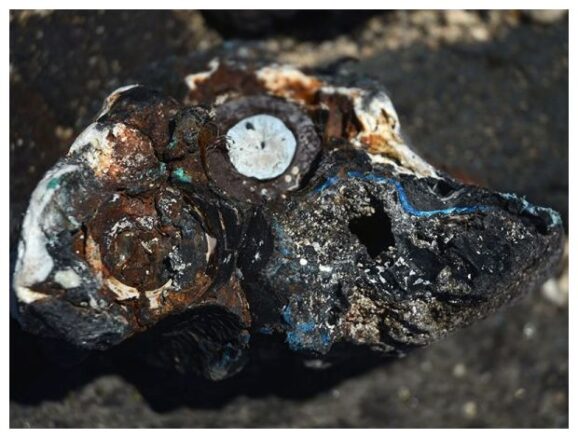Plastic Waste Forms New Kind Of Stone
This article is more than 2 years old
 Even though some people are finding ingenious ways to avoid using plastic and/or to use plastics to make other goods, there’s no doubt that our use of plastics is a huge environmental problem. Since the 1950s, about six billion tons of plastic has been manufactured, and a considerable percentage of that plastic ends up in the trash. As we know, plastic can’t biodegrade or even really decompose, but researchers have recently learned that it’s doing something they didn’t expect — it’s becoming a kind of stone.
Even though some people are finding ingenious ways to avoid using plastic and/or to use plastics to make other goods, there’s no doubt that our use of plastics is a huge environmental problem. Since the 1950s, about six billion tons of plastic has been manufactured, and a considerable percentage of that plastic ends up in the trash. As we know, plastic can’t biodegrade or even really decompose, but researchers have recently learned that it’s doing something they didn’t expect — it’s becoming a kind of stone.
In a recent article in the Geological Society of America Today, researchers aimed to investigate the ways in which plastics are preserved or, for lack of a better word, fossilized. During the course of their study, researchers found a new material they call “plastiglomerate” on the beaches of Hawaii. The “stone” is a combination of melted plastic, sediment, lava chunks, and other organic matter found at the beach. When these materials combine, they become too dense and big to burn or to be carried off by the wind, so they accumulate, often getting buried by sand and other debris. In fact, plastiglomerate is so robust that the researchers expect it to become a permanent fixture in Earth’s geologic history, much like real fossils.
The material was actually first discovered back in 2006 by an oceanographer conducting surveys on Hawaii’s beaches, but it took a while for other scientists to become curious about the finding and conduct more research. An earth scientist from Western University in Ontario, Patricia Corcoran, flew to Hawaii to collect her own samples from 21 sites. The plastic was melted and mixed into hard balls, which local residents said were from bonfires; apparently, many people attempt to get rid of plastic and other waste by burning it, which only turns the plastic into something akin to a synthetic lava rock.
The finding adds support to the idea that we are in the era of the anthropocene, a term coined in the 1980s to categorize a geological era significantly impacted by human activity. It’s thus far an unofficial term, rather than one you’d see in a science text, but findings such as plastiglomerate push the anthropocene designation closer to official acceptance, as it becomes more and more difficult to deny that humans have, are, and will continue to drastically affect the planet’s ecosystems. It’s a sobering thought that when future geologists study the Earth’s of earth’s formation, the plastics era will be among them.












